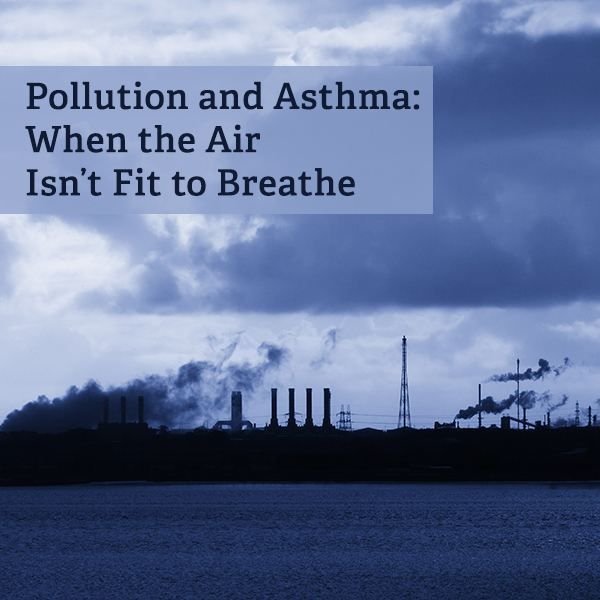Pollution and Asthma: Diesel Pollution & Causes of Asthma
Nothing New
Air pollution is not a new problem. Since the days of the industrial revolution, cities have been blackened coal, wood and diesel smoke. While we have progressed to homes heated by electricity and natural gas, air pollution has increased, especially in urban areas where industries cluster with traffic that runs non-stop in, through and around local neighborhoods.
With the ever-increasing pollution, come health issues such as asthma, the fastest-growing chronic disease in the U.S. according to government statistics.
Those at Risk
The primary victims of chronic air pollution are the young, elderly and those with compromised immune systems. In the past several years, school systems (many low-income) located in urban areas have experienced a dramatic increase of students with asthma. The Environmental Defense Fund reports that one-quarter of the children in New York’s Harlem district have asthma. In addition, across the country in California studies showed an increase in childhood asthma in children whose schools were near highways and interstates, giving rise to the belief that exposure to diesel fumes are responsible.
Statistics, also, show that children of African-American and/or Latino decent have higher incidents of asthma and that these children are more likely to live as well as go to school within the congested city limits.
Root Cause
While asthma attacks can be triggered by cigarette smoke as well as allergens, such as pollen, the increase in diagnosis of asthma in children appears to be directly linked to exhaust fumes. Diane Bailey of the Natural Resources Defense Council reported that, “One major study found that components of diesel exhaust including particulate matter can cause biologic responses that are related to asthma; this exposure is associated with the inflammatory and immune responses involved in asthma.”
Since many schools are located near major highways, the constant flow of diesel-fueled trucks and busses present a growing threat to the health of students, even when the students live in suburban or rural areas, as reported by Bailey. “A study of thirteen Southern California communities found that children exposed to traffic-related pollution in school were more likely to develop asthma irrespective of residential exposure.”
In addition, studies taken in the Netherlands of over 1,000 children found that “asthma, wheezing, coughs, and runny nose were significantly more common in children living within 330 feet of freeways; and higher asthma rates were significantly associated with increasing levels of diesel truck traffic.”
In England, a study of 10,000 children showed symptoms to be more likely if the child’s home was near a main road, with the highest risk found in homes within 300 feet of the roadways. Again, diesel truck traffic played a significant role in the pollution levels.
Solutions
The obvious solution to all this is to keep traffic away from school zones, which of course is easier said than done. Re-routing traffic in an urban environment presents logistical nightmares.
An alternative solution, one that should be at the top of every transportation developer’s list is to design and create vehicles that no longer emit diesel fumes laden in particulates that inflame the lungs of our children. Or come up with other means of transportation that would eliminate pollution.
Some supporters for alternatives to diesel promote the use of natural gas by trucking firms. Others believe promoting a national rail system would provide a safer more efficient system.
Natural Gas Trucking
Natural gas, which burns cleaner than other fuels, especially diesel, has been used to fuel trucks for several years. One of the first companies to go “Clean” was Waste Management, Inc. They use natural gas in their garbage trucks. Other trucking concerns have followed suit, but not enough to change the levels of pollution in and around urban schools.
Supporters of natural gas trucks say that not only do these vehicles keep the air cleaner; they are less expensive than their diesel fed counterparts. This would seem to be a win/win situation, but is it?
Opponents to natural gas trucking point out that the process of obtaining natural gas, fracking, has been found to produce higher levels of ozone than found in major cities. In addition, this process causes issues with the water table, which concerns residents who rely on wells for their water.
Super Rail System
On the other hand, there are those who feel that renovating and rejuvenating the US rail service would eliminate the problems of pollution by providing fast, clean (electric) transportation both for commuters as well as industry. Opponents of this solution point out that the trucking industry, which employs thousands of people, would be severely impacted by rail service.
Clean Air AND Clean Transportation
This does not need to be an either or solution. If we have both pollution-free trucking and electronic high-speed rail, the two could co-exist. In addition, if car manufacturers stepped up the pace of providing hybrid cars, while industry eliminated fossil fuels from their plants, the air around the world would be cleaner. Cleaner air results in cleaner lungs.
Diesel pollution is one of the foremost causes of asthma in children today. Any and all solutions to eliminate diesel fumes from the air we breathe should be considered seriously.
References
- Environmental Defence Fund: Asthma and Air Pollution - http://www.edf.org/health/air/asthma
- Bailey, D. (2011) Switchboard. Diesel Pollution and Asthma - http://switchboard.nrdc.org/blogs/dbailey/diesel_pollution_and_asthma_mo.html
- Steel Interstate: Why not Convert Trucks to Natural Gas - http://www.steelinterstate.org/topics/why-not-convert-trucks-natural-gas#Fracking
- O’Neil, C. (2011) Times Free Press. LGN Trucks Reduce Pollution from Mohawk shipments - http://www.timesfreepress.com/news/2011/sep/10/lng-trucks-reduce-pollution-from-mohawk/
